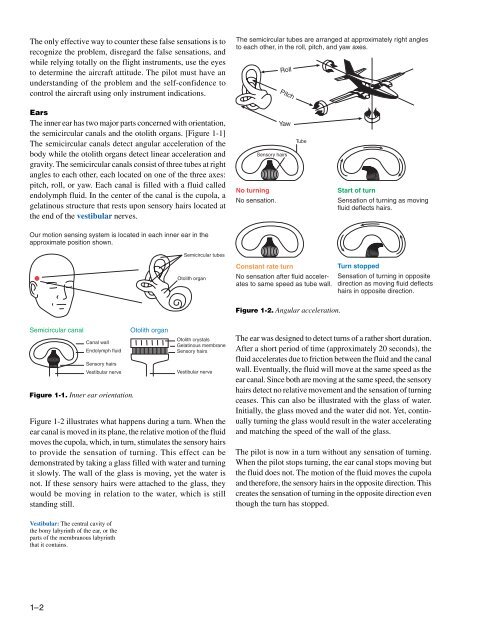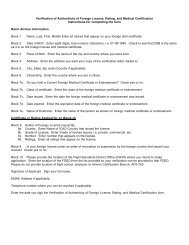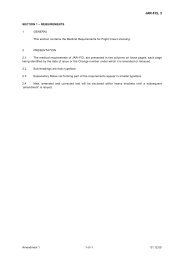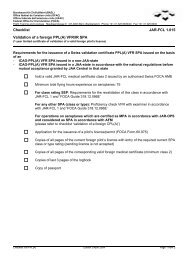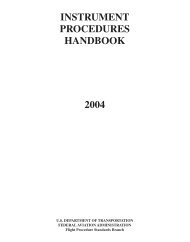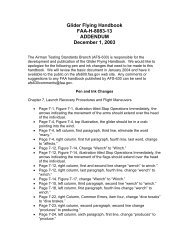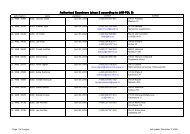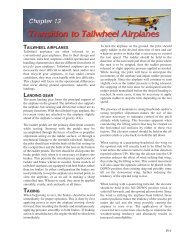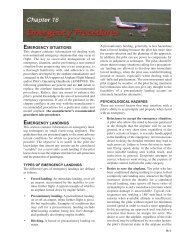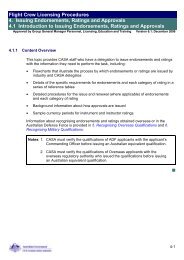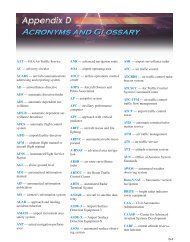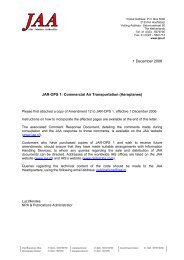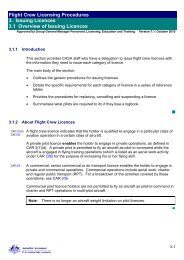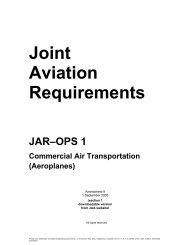FAA-H-8083-15, Instrument Flying Handbook -- 1 of 2 - US-PPL
FAA-H-8083-15, Instrument Flying Handbook -- 1 of 2 - US-PPL
FAA-H-8083-15, Instrument Flying Handbook -- 1 of 2 - US-PPL
You also want an ePaper? Increase the reach of your titles
YUMPU automatically turns print PDFs into web optimized ePapers that Google loves.
The only effective way to counter these false sensations is torecognize the problem, disregard the false sensations, andwhile relying totally on the flight instruments, use the eyesto determine the aircraft attitude. The pilot must have anunderstanding <strong>of</strong> the problem and the self-confidence tocontrol the aircraft using only instrument indications.EarsThe inner ear has two major parts concerned with orientation,the semicircular canals and the otolith organs. [Figure 1-1]The semicircular canals detect angular acceleration <strong>of</strong> thebody while the otolith organs detect linear acceleration andgravity. The semicircular canals consist <strong>of</strong> three tubes at rightangles to each other, each located on one <strong>of</strong> the three axes:pitch, roll, or yaw. Each canal is filled with a fluid calledendolymph fluid. In the center <strong>of</strong> the canal is the cupola, agelatinous structure that rests upon sensory hairs located atthe end <strong>of</strong> the vestibular nerves.Figure 1-2. Angular acceleration.Figure 1-1. Inner ear orientation.Figure 1-2 illustrates what happens during a turn. When theear canal is moved in its plane, the relative motion <strong>of</strong> the fluidmoves the cupola, which, in turn, stimulates the sensory hairsto provide the sensation <strong>of</strong> turning. This effect can bedemonstrated by taking a glass filled with water and turningit slowly. The wall <strong>of</strong> the glass is moving, yet the water isnot. If these sensory hairs were attached to the glass, theywould be moving in relation to the water, which is stillstanding still.The ear was designed to detect turns <strong>of</strong> a rather short duration.After a short period <strong>of</strong> time (approximately 20 seconds), thefluid accelerates due to friction between the fluid and the canalwall. Eventually, the fluid will move at the same speed as theear canal. Since both are moving at the same speed, the sensoryhairs detect no relative movement and the sensation <strong>of</strong> turningceases. This can also be illustrated with the glass <strong>of</strong> water.Initially, the glass moved and the water did not. Yet, continuallyturning the glass would result in the water acceleratingand matching the speed <strong>of</strong> the wall <strong>of</strong> the glass.The pilot is now in a turn without any sensation <strong>of</strong> turning.When the pilot stops turning, the ear canal stops moving butthe fluid does not. The motion <strong>of</strong> the fluid moves the cupolaand therefore, the sensory hairs in the opposite direction. Thiscreates the sensation <strong>of</strong> turning in the opposite direction eventhough the turn has stopped.Vestibular: The central cavity <strong>of</strong>the bony labyrinth <strong>of</strong> the ear, or theparts <strong>of</strong> the membranous labyrinththat it contains.1–2


